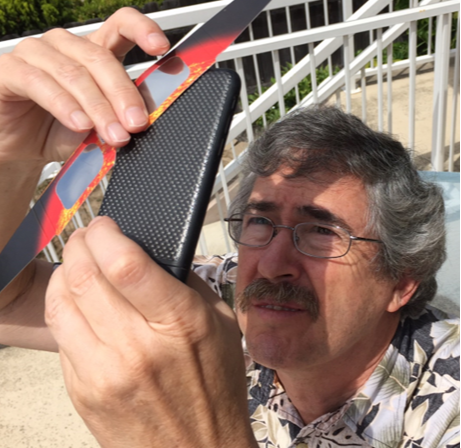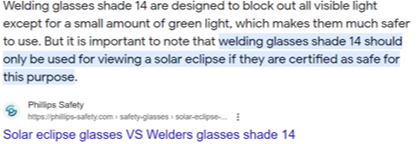Frequently asked Eclipse questions
How many stops should a solar filter be for the eclipse?
Solar filters do not have “stops”. They conform to the ISO specifications and block out 100% of ultra-violet and 100% of infrared and 99.999% of white light.

Should I use a teleconverter on my zoom lens? Will it affect image quality?
You can, but they typically do affect image quality somewhat. You might be better off not using a teleconverter and just cropping in on the eclipse image. Depends on the number of pixels you have, and what you are trying to compose.
What ratings for eyewear are recommended to safely view the eclipse?
See #1 above. Eyewear MUST conform to Solar Glasses specifications to be safe.
What sources for solar filters do you suggest?
greatamericaneclipse.com is our go-to for solar glasses. Thousand Oaks Optical is our go-to for slip-on front-of-lens solar filters. There are others (i.e., Rainbow Symphony)…just be sure they have the statements as noted in #1.
What is the difference between a partial and total eclipse?
The sun is not 100% covered for a partial eclipse. See “Solar Eclipse Types” in the “Annular vs. Total Solar Eclipse section of the recording. By definition, all phases of an annular solar eclipse are “partials” as the disk of the sun is not 100% covered by the moon.
How do I determine what locations are best for viewing an eclipse?
We have a whole section on that Under “Location vs What you’ll See” section of recording. Lots of maps and apps to help. This is personal based on what else you want to do on your trip. Try for the center line, with a good weather forecast for the best experience.
Is it necessary to have a tracking device on your tripod to account for the earth’s rotation?
Not necessary, but helpful. Without one, you must keep recentering during the eclipse.
What eyewear is recommended for viewing the eclipse?
Solar Eclipse Glasses. See #1 & #4 above. They MUST conform to specs noted in #1.
Is it safe to view the eclipse through your LCD screen in “live view” mode of your camera?
Live view with a solar filter is safe for you and your camera. Live view without a solar filter, or with ND filters, will risk your camera. ND filters state “not for optical viewing” so you MUST use “live view”, but not for very long due to heat coming into the lens.
What memory card size and speeds are recommended for photographing the eclipse?
Use a fast and large-capacity card. Test your buffer before the event to see how long it takes for it to fill up.
Should I use front-element mounted filters or drop-in filters for my lens?
The only way to protect you and your gear is with a Solar Filter on the front of any lens. Drop-in filters are not ok as they are between lens and camera. Heat will accumulate in the lens if you do this.
What changes the color of the sun when using filters?
Different filters give different colors based on their composition. Color is easily changeable in Photoshop to whatever color you’d like.
What changes the color of the sun when using filters?
Different filters give different colors based on their composition. Color is easily changeable in Photoshop to whatever color you’d like.

May I pre-focus on a distant object and then use gaffer’s tape to ensure my lens stays focused, then set my lens (or camera) to Manual Focus so it does not shift when I push the shutter button?
It’s a good idea to tape over AF/MF switch, too, so you don’t accidentally switch before removing tape.
May I use Shade 14 welder’s glass in front of my lens to safely photograph and view the eclipse?
It’s been done. Gives a green tint to the sun but that can be fixed in PS. From Google:

Do you need protective eyewear if you are never “staring” at the sun/eclipse?
Not if you NEVER look at the sun. During the total eclipse the sun is covered so it is safe. There are indirect methods to watch (such as the pinhole method in the “How to Photograph them Safely” section of the recording.)
What white balance settings should I use?
We use “Sun” but shoot RAW. Any white balance but AUTO can work or be adjusted in post processing. Auto is affected by any external light source such as a car or street light coming on.
How can you include foreground in images of the eclipse?
Good question. Some professional photographers have used ND filters, but we have not as it is not safe for optical viewing. See ND Filter Warnings under “How do you view them safely” section of recording. Wider angle lenses work better as the eclipse will usually be high in the sky and smaller in the image. You can do a composite or blended image to be safer. For a total solar eclipse, the sun is covered by the moon, it will be dark, and you can shoot with any lens or zoom without filter. For an annular solar eclipse, the solar filter must remain on the lens for protection during the entire event. We have not found any ND filters that ensure safe optical viewing and photography.
How can you include foreground in images of the eclipse?
Good question. Some professional photographers have used ND filters, but we have not as it is not safe for optical viewing. See ND Filter Warnings under “How do you view them safely” section of recording. Wider angle lenses work better as the eclipse will usually be high in the sky and smaller in the image. You can do a composite or blended image to be safer. For a total solar eclipse, the sun is covered by the moon, it will be dark, and you can shoot with any lens or zoom without filter. For an annular solar eclipse, the solar filter must remain on the lens for protection during the entire event. We have not found any ND filters that ensure safe optical viewing and photography.
What is the difference between an annular and total eclipse?
For the annular, the moon is not large enough in the sky to fully cover the sun, making a “Ring of Fire”. Filters MUST be used AT ALL TIMES during the annular eclipse. See “Annular vs. Total Solar Eclipse” section of the recording. During a total solar eclipse, the moon’s image totally covers the sun.
Do I need a tripod to photograph the eclipse with a zoom lens?
Not necessary but it certainly helps. Especially if you have a zoom of 300mm or more. See section, “How to Photograph them Safely” for eclipse image sizes and framing based on zoom.
How does one capture Bailey’s Beads?
Bailey’s Beads only occur during a total solar eclipse. Bracket and shoot like crazy on “continuous high” starting about 10 seconds before 2nd contact as you have recentered the image and taken off the solar filter. Then shoot normally through totality and then shoot like crazy just as the sun’s rays start to show at 3rd contact. See “Viewing from the Centerline” under “Location vs. what you’ll see - 2024 Total” section of the recording.
Under what circumstances should you view the eclipse through your camera’s viewfinder?
ONLY if you have a SOLAR FILTER on the front. Not an ND filter. However, during a total solar eclipse, in totality the moon covers the sun so it is safe to view without filters through the viewfinder. But at 3rd contact the filter goes back on.
I want to practice my photography for the solar and/or annular eclipse? What opportunities are there for me to practice ahead of time?
Hopefully there are plenty. Just use a sunny sky day, the same time as the eclipse contacts, and then you can use the altitude information for correct angle you will be shooting. Based on there being lots of sunspots, see spaceweather.com, you can use them to evaluate your focus.
When I have my camera set up, aimed at the sun, but am not taking images, should I cover the front element of my lens with something?
Yes. Use a white t-shirt, or something light-colored and lint-free. Cover the camera and front of lens for best heat resistance.
If I am using a solar filter on the front of my lens, should I remove other lens filters?
Mary doesn’t and hasn’t had issues, and Les usually takes off the UV filter.
How do I focus my camera for the eclipse?
Auto-focus on a very distant object (mountain, building, etc. in distance), then put lens and camera on manual focus. You can use gaffer’s tape to lock focus ring but remember to take it off before switching back to auto-focus or you will break the lens motors. We like to put tape over that switch, too, so we don’t forget to take it off.
Is it possible to photograph the eclipse well from a boat?
Depends on the boat😉. The big ships nowadays have good stabilizers. If it’s an “eclipse cruise”, they will be especially aware of the issue. Smaller boats probably will be much more difficult.
Is there a preferred set of exposure settings for shutter, aperture, and ISO?
See the later part of the recording under “How to photograph them safely” and “Balancing the experience with photography”, for general settings and example images showing settings used. The “Mr. Eclipse chart” showing point solutions helps with capturing individual phenomenon.
If my camera has built-in ND filters, should I use them?
No. They wouldn’t be strong enough and they are not in front of lens. They may also just be an electronic calculation in the camera.
Is there a preferred set of exposure settings for shutter, aperture, and ISO?
See the later part of the recording under “How to photograph them safely” and “Balancing the experience with photography”, for general settings and example images showing settings used. The “Mr. Eclipse chart” showing point solutions helps with capturing individual phenomenon.
Should I disable “Retract lens on Power Off” when using Canon or any camera with this feature?
Yes, if you don’t want to have to keep redoing the focus, should you shut the camera off at any time, OR IT GOES TO SLEEP.

